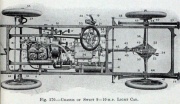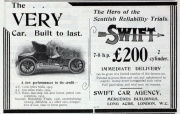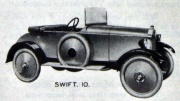Swift Motor Co: Cars







































Note: This is a sub-section of Swift Motor Co.
1900 Swift Cycle Co made their first single cylinder car using an MMC engine. It had an unusual transmission system involving an unsprung two ratio rear axle.
1902 The Swift Motor Co was formed.
1902 August. Details of the 4.5-hp voiturette.[1]
1902 October. Detailed report of their voiturette.[2]
1903 The design was unreliable and was replaced by a more conventional layout.
1904 The first Swift-engined car was the twin-cylinder 7 h.p. and later 10 h.p. This was shortly afterwards joined by the four-cylinder 12/14 which continued in a bewildering number of guises until the First World War.
1905 February. Details of their 7-hp car.[3][4]
1906 Produced 7-8 (two-cylinder), 9-10 (two and three cylinders), 12-14 and 16-20 h.p. (both four-cylinder) cars with shaft-drive. [5]
1906 September. Details of their 9-10 hp engine.[6]
1907 November. Details of their 25-30-hp car.[7] Later mention the 10-12hp and 18-24hp cars.[8]
1908 November. Details of the 10-12-hp and 15-18-hp cars shown at Olympia.[9]
1909 October. Details of the 7-hp car made jointly by Austin and Swift.[10]
1911 October. Details of the new 8hp and 10-12hp cars. Continuing with the 7hp car for 1912.[11][12][13]
1912 November. Details of the 10hp (4), 12hp (4) and 15hp (4) cars.[14]
1913 A larger car, the 15, with 3 litre engine was added to the range, and this continued to just post war.
1913-1917 For a list of the models and prices see the 1917 Red Book
1913 October. Details of the cars for next year: Two new models (15.9hp and 11.9hp) and an improved two-cylinder light car.[15]
1914 September. Details of the new 10-hp four-cylinder car.[16]
1914 November. Details of the 10hp, 11.9hp and the 15.9hp cars. Electric lighting on all models.[17]
1917 October. Details of the 10hp car.[18]
Post-WWI. The range was simplified with the excellent 1,100cc 10 continuing and joined by a 2 litre 12 with a four-speed gearbox.
1923 A new 10 was launched, as the Q Type, with coil ignition, electric starting, optional front wheel brakes and a top speed of 55mph.
1925 The 12 was replaced by the 12/35, with front wheel brakes, plate clutch and two feet extra in the wheelbase.
1926 Standard front wheel brakes were added, and the engine was bored out to 1190cc to become the P type.
1929 The engine size grew again, to 1307cc, when the car became the P2.
1930 The final Swift car was the 1930 Cadet, which was an attempt to compete with the £100 cars. This had an 850cc Coventry Climax engine and a price of £149 for the tourer and £165 for the saloon but Swift was too small to compete with the like of Ford and Morris and closed in 1931.
1931 Swift 10 Model 5P exhibit. [19]
Early Registrations
- 1921 AF 4607
See Also
Sources of Information
- ↑ The Autocar 1902/08/09
- ↑ Automotor Journal 1902/10/18
- ↑ Automotor Journal 1905/02/25
- ↑ Automotor Journal 1905/03/04
- ↑ The Automobile Vol. III. Edited by Paul N. Hasluck and published by Cassell in 1906.
- ↑ Automotor Journal 1906/09/08
- ↑ Automotor Journal 1907/11/16
- ↑ Automotor Journal 1907/12/07
- ↑ Automotor Journal 1908/11/28
- ↑ The Autocar 1909/10/23
- ↑ The Autocar 1911/10/14
- ↑ The Autocar 1911/10/21
- ↑ The Autocar 1911/11/04
- ↑ The Autocar 1912/11/02
- ↑ The Autocar 1913/10/04
- ↑ The Autocar 1914/09/19
- ↑ The Autocar 1914/07/07
- ↑ Light Car and Cyclecar 1917/10/01
- ↑ Museum of Country Life at Exmouth

